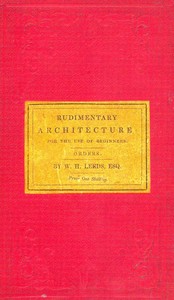Rudimentary Architecture for the Use of Beginners by W. H. Leeds
"Rudimentary Architecture for the Use of Beginners" by W. H. Leeds is a foundational architectural treatise written in the mid-19th century. This work serves as an introductory guide to the classical orders of architecture, focusing on both the aesthetic principles and structural elements that define them. The author aims to make the appreciation and understanding of architecture accessible to amateurs and professionals alike, highlighting the distinction between mere building and architecture as
a fine art. The opening of the treatise elaborates on the importance of grounding architectural rules in clear explanations of principles to foster genuine understanding, particularly for beginners. Leeds differentiates between the practical aspects of building and the artistic qualities of architecture, which he believes should evoke aesthetic pleasure. He begins by outlining the classical architectural orders—Doric, Ionic, and Corinthian—and discusses their essential characteristics. The text emphasizes that architecture transcends mere functionality by inviting readers to appreciate its artistic and cultural significance. Through detailed discussions of each order's components, such as columns, entablatures, and decorative features, Leeds sets the stage for a deeper exploration of classical architecture's lasting impact on modern design. (This is an automatically generated summary.)
Read or download for free
| How to read | Url | Size | |||
|---|---|---|---|---|---|
| Read now! | https://www.gutenberg.org/ebooks/65462.html.images | 256 kB | |||
| EPUB3 (E-readers incl. Send-to-Kindle) | https://www.gutenberg.org/ebooks/65462.epub3.images | 1.4 MB | |||
| EPUB (older E-readers) | https://www.gutenberg.org/ebooks/65462.epub.images | 1.4 MB | |||
| EPUB (no images, older E-readers) | https://www.gutenberg.org/ebooks/65462.epub.noimages | 150 kB | |||
| Kindle | https://www.gutenberg.org/ebooks/65462.kf8.images | 1.5 MB | |||
| older Kindles | https://www.gutenberg.org/ebooks/65462.kindle.images | 1.5 MB | |||
| Plain Text UTF-8 | https://www.gutenberg.org/ebooks/65462.txt.utf-8 | 230 kB | |||
| Download HTML (zip) | https://www.gutenberg.org/cache/epub/65462/pg65462-h.zip | 1.6 MB | |||
| There may be more files related to this item. | |||||
About this eBook
| Author | Leeds, W. H. (William Henry), 1786-1866 |
|---|---|
| LoC No. | 2008570385 |
| Title |
Rudimentary Architecture for the Use of Beginners The Orders and Their Æsthetic Principles |
| Alternate Title |
Rudimentary Architecture for the Use of Beginners The Orders and Their Aesthetic Principles |
| Contents | The Orders generally -- First Order: Ancient Doric. Modern Doric. Tuscan -- Second, or voluted-capital, Order: Greek Ionic. Roman and Modern -- Third, or foliaged-capital Order: Corinthian. Composite -- Columniation: forms and denominations of temples and porticoes -- Intercolumniation -- Glossarial index. |
| Credits | Charlene Taylor and the Online Distributed Proofreading Team at https://www.pgdp.net (This file was produced from images generously made available by The Internet Archive) |
| Reading Level | Reading ease score: 45.3 (College-level). Difficult to read. |
| Language | English |
| LoC Class | NA: Fine Arts: Architecture |
| Subject | Architecture -- History |
| Subject | Architecture -- Orders |
| Subject | Architectural design |
| Category | Text |
| EBook-No. | 65462 |
| Release Date | May 28, 2021 |
| Most Recently Updated | Oct 18, 2024 |
| Copyright Status | Public domain in the USA. |
| Downloads | 167 downloads in the last 30 days. |
| Project Gutenberg eBooks are always free! | |

